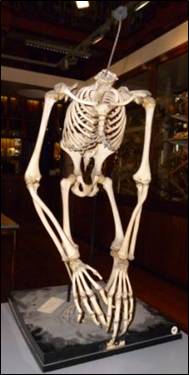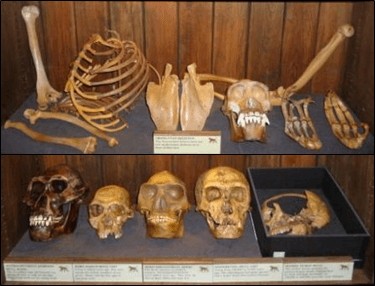How To: Find Your Head
By Emma-Louise Nicholls, on 10 July 2013
 Do you having any burning desires to have something explained by someone on the inside? This blog series is a How To Guide for the museological musings of a Museum Assistant. The second along this (hopefully) long and happy blogging path is…
Do you having any burning desires to have something explained by someone on the inside? This blog series is a How To Guide for the museological musings of a Museum Assistant. The second along this (hopefully) long and happy blogging path is…
How To: Find Your Head
There are a number of reasons, you may have been concerned about this, as to why at the Grant Museum you could have come to lose your head. When the collection was in its embryological state, over 180 years ago, it first came in to being as a cohesive group of objects under the guise of being a teaching collection. This is still a focus of the collection today (hence our ‘weird’ opening hours) and subsequently no specimen is safe (except a very select few) from the threat of being handled by keen, and reluctant, students alike. Several of these teaching practicals require specimens to be de-taxonomised (stripped of identification) which has led to all sorts of potential for human re-taxonomising errors over the years. This open access extends to researchers and academics who also wish from time to time to don the nitrile gloves of handling. Plenty of scope for your head being put back in the wrong box or your label being reattached to the wrong specimen. (NEVER by the current Museum Assistant).
 It’s not just handling that can land your head in trouble. It may also get disassociated from your body due to permanent or temporary display in the Museum. Perhaps your body won’t fit in the case, your lack of articulation is an aesthetic nightmare, or its presence just isn’t necessary to make the point of the exhibition (see images on the right). With the best will in the world, associated material can get, well, disassociated. Maybe pests ate your metaphorical driver’s licence, for example. A more physically active excursion for your head may be caused by going on outreach (museum staff taking specimens to libraries, schools, etc, to do a little hands-on teaching), or on loan to another museum. These are just two of the reasons as to why your head may have gone further afield.
It’s not just handling that can land your head in trouble. It may also get disassociated from your body due to permanent or temporary display in the Museum. Perhaps your body won’t fit in the case, your lack of articulation is an aesthetic nightmare, or its presence just isn’t necessary to make the point of the exhibition (see images on the right). With the best will in the world, associated material can get, well, disassociated. Maybe pests ate your metaphorical driver’s licence, for example. A more physically active excursion for your head may be caused by going on outreach (museum staff taking specimens to libraries, schools, etc, to do a little hands-on teaching), or on loan to another museum. These are just two of the reasons as to why your head may have gone further afield.
So far your life has gone like this…
1) Born
2) Died (there’s probably a lot in between 1 and 2 so you may expand on this list with subsections if you wish)
3) Your disarticulated skeleton found its way to the Museum
4) Your head got separated from your body by any of the means outlined above
5) You get a rush from the crazy pseudo-out of body experience at first but after a while it gets old and you reach the somewhat inevitable conclusion that life is sweeter with your noggin on your shoulders
6) You go on a quest to locate it
I’d start with the Museum’s database. If you were labelled and accessioned properly when you arrived, that will tell you exactly what your heads’ location should be. It may be complicated by the fact that all 68,000 specimens had to be location checked after our move two years ago. But let’s hope you’re in the ‘done’ pile. If you are not on the database, it becomes a treasure hunt concerning all cupboards, drawers, cases, shelves, and both store rooms with a dose of educated guessing. If you’re a baboon, your head will most likely be in the primate drawers, for example. Though in a drawer full of a million baboon skulls, let’s hope you’re labelled.
 On your quest, the lost property of the osteological world turns up a few potential candidates. How do you tell which skull is yours? You will be unpopular if you pick up someone else’s a) because you will have left your unidentified disembodied head lying around to clog up the place and b) you have facilitated the continuation of another disemheaded body. Not cool. To establish which belongs to you, you will need to establish some facts before you can get started:
On your quest, the lost property of the osteological world turns up a few potential candidates. How do you tell which skull is yours? You will be unpopular if you pick up someone else’s a) because you will have left your unidentified disembodied head lying around to clog up the place and b) you have facilitated the continuation of another disemheaded body. Not cool. To establish which belongs to you, you will need to establish some facts before you can get started:
1) Who’s your daddy?
2) Know your sex
3) Did you live long and prosper, or live fast and die young?
 Let’s say you decided you are an adult male and your dad was a gorilla. By comparing the head of another gorilla with the skeletal swag produced by your search, you can work out which skulls are of the correct genetic disposition. This is what we affectionately like to call ‘comparative anatomy’. Next is the sex. Fortunately for you, male and female gorilla skulls are easy to tell apart based on the sagittal crest- i.e. a big ridge of bone that runs along the top of the skull in the males (see image right). Its use is muscle attachment for the strong jaws. Fyi. So, make sure (if you have a choice to make) that you select the right sex, otherwise the future use of public toilets will become a conundrum. Finally, if you have the head of a 60 year old but the body of a 20 year old, well, go you! But it’s probably not correct. Size is a good indicator of age, though more intense comparative anatomy will narrow it down further.
Let’s say you decided you are an adult male and your dad was a gorilla. By comparing the head of another gorilla with the skeletal swag produced by your search, you can work out which skulls are of the correct genetic disposition. This is what we affectionately like to call ‘comparative anatomy’. Next is the sex. Fortunately for you, male and female gorilla skulls are easy to tell apart based on the sagittal crest- i.e. a big ridge of bone that runs along the top of the skull in the males (see image right). Its use is muscle attachment for the strong jaws. Fyi. So, make sure (if you have a choice to make) that you select the right sex, otherwise the future use of public toilets will become a conundrum. Finally, if you have the head of a 60 year old but the body of a 20 year old, well, go you! But it’s probably not correct. Size is a good indicator of age, though more intense comparative anatomy will narrow it down further.
Assuming your skull is there, you should by now have ascertained which is yours. Place said head squarely on your shoulders, ensure it is adequately attached, and voila. Away you go.
The next in our series of How To Guides will be three long weeks from now. Try to be patient.
Emma-Louise Nicholls is the Museum Assistant at the Grant Museum of Zoology
 Close
Close

